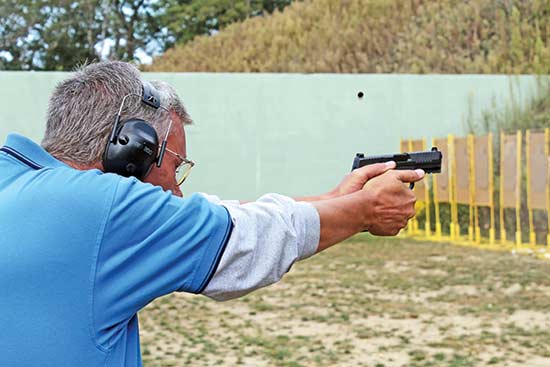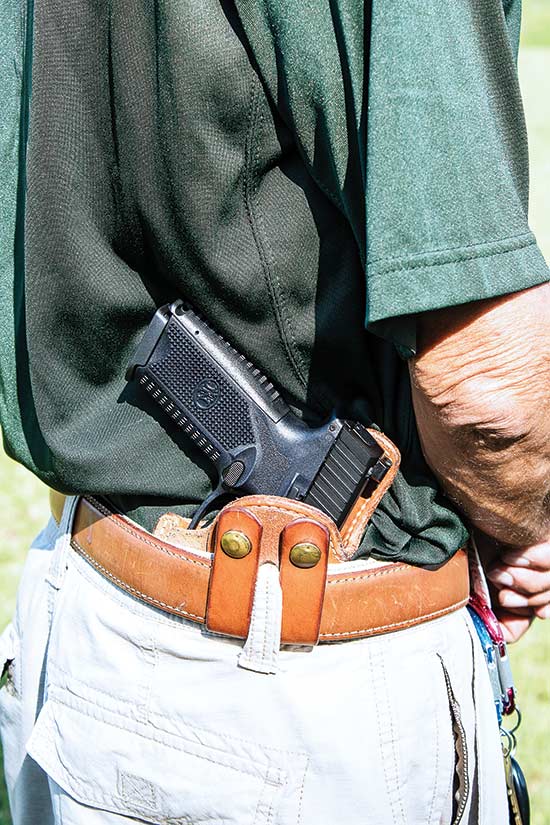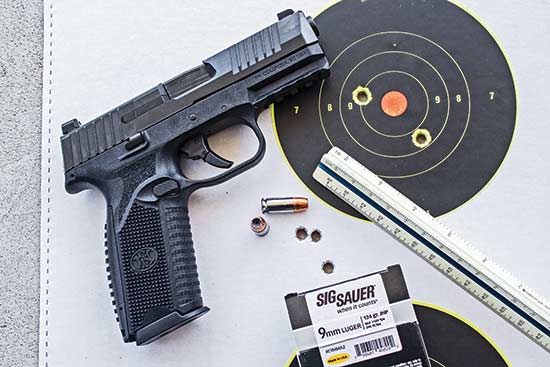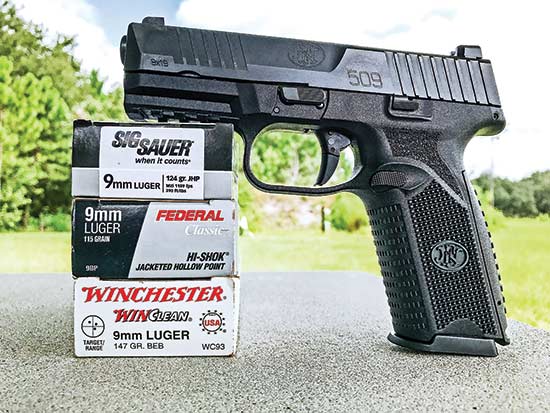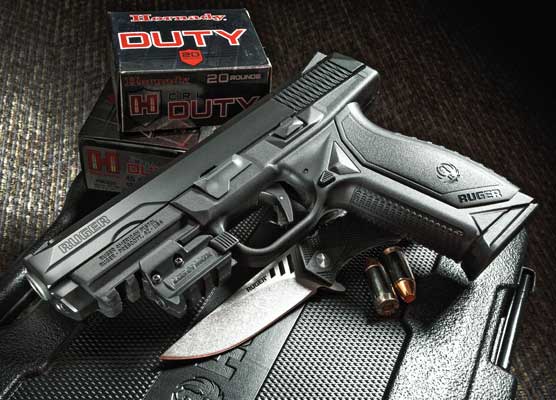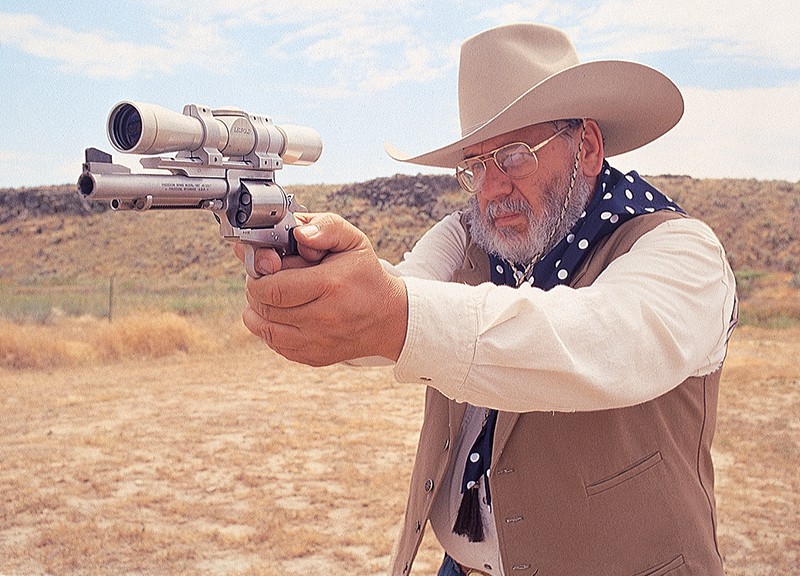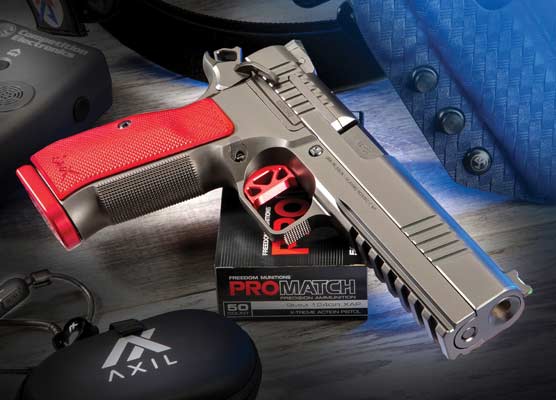Ready to Serve: The FN 509
Not Just Another Striker-Fired 9mm Service Pistol!
FN’s 509, essentially an improvement over the FNS introduced about 3 years ago, joins the legion of polymer Parabellum pistols vying for the market established and dominated by Glock. The polymer FN pistols have already been winning major matches in the hands of FN’s sponsored world champion shooter Dave Sevigny, and Dave was quite high on the 509 when I discussed it with him at one of the shows a few months ago. Let’s see how our sample stacked up.
Like most of its genre, the 509 is a blocky-looking pistol. Its long grip makes its 4-inch barrel and proportional length slide look short (picture a Glock 19 upper on a Glock 17 frame, and you’ll have an idea of the proportions). This pistol is proudly “Made In USA,” specifically in Columbia, South Carolina.
The all-metal magazine (our sample came with two) holds 17 rounds of 9mm to back up the one in the chamber. It inserts smoothly and falls free cleanly. Even with my old arthritic hands, it was no problem loading it all the way up, or thumbing rounds out of a full magazine to change ammo.
First Look
The now seemingly obligatory 1913 rail is present, for light/laser attachments. Another modern standard is present, interchangeable backstraps. Our test gun came with two.
FN has worked to make this pistol ambidextrous. Slide stop lever and magazine release button each have mirror image counterparts on the opposite side of the frame. A similarly ambidextrous thumb safety is optional, working from the shooter’s perspective like a 1911’s: up is safe, down is fire. This optional feature was not present on our test sample. Sights are big and blocky, with luminous (but not self-illuminating) green dots. Yes, they have to have been very recently exposed to light to glow, but when they are, they give an awesomely good sight picture in poor light.
Trigger
FN specifies the trigger pull as 5.5 to 7.5 pounds. It felt more like the 8-pound range to me, but we always weigh the triggers anyway. This one turned out to average 8.85 pounds when weighed at the center, where the shooter’s trigger finger generally lies. Measured at the toe, the bottom tip of the trigger, the Lyman digital gauge from Brownell’s registered an average of 6.5 pounds, right in the middle of FN’s stated range. I suspect the factory (like most) took the measurement low on the trigger, where greater leverage requires less pressure.
There’s more to trigger pull-quality than weight, of course. There’s pace, and perhaps most important, smoothness. Our test 509, serial number GKS0001514, exhibited “creep” as noted by all on the test team. That is, as the trigger began coming back, it transmitted little “catches” to the trigger finger as the internal parts moved against each other. This was less noticeable in rapid fire. There was also palpable backlash, or additional rearward movement of the trigger after the sear released. In between that draggy take-up and the shot, the pull “at the wall” (i.e., just before discharge) felt about like a Glock with an 8-pound connector. Some FN 509 owners have reported excellent triggers, so sample GKS0001514 may have simply been an exception.
Running The Gun
The stout recoil spring assembly requires a vigorous effort to rack the slide of the FN 509. It’s not the pistol to buy for your great grandmother with osteoporosis and arthritis.
The ambidextrous magazine release was appreciated by this old man, who has some arthritis of his own in the dominant hand thumb among other places. On both sides, the frame is molded to shield the release buttons from being inadvertently depressed and turning your 17+1 round auto pistol into a single-shot. However, this did not prevent deliberate, clean release of an empty magazine when depressing either side, whether using thumb or trigger finger. The latter method is faster for a lot of people, and very likely safer since it gets the finger out of the trigger guard.
Slide lock/slide release levers are also ambidextrous. On either side, they make it easy to lock the slide open without a magazine in place for inspection. Even though molding in the frame shields the levers on either side from a thumb inadvertently pushing them up and locking the slide open in mid firing cycle, they performed as intended in the hands of all testers.
However, pressing down on these levers to close the slide and chamber a live round was another matter. This required considerable exertion. I had to work awfully hard to close the slide 1-handed via the lever. Yes, FN lists the part in its nomenclature sheet as a “slide stop,” but if pushing it down releases the slide, well, it is also a slide release.
I found I needed significant pressure with the support hand thumb to close the slide via the lever during speed reloads, and it was sufficiently difficult with the thumb of the firing hand that if I’d had to perform a 1-hand-only “injured shooter” reload with it, I would have released the slide with a tug instead of fighting the lever. This would have been easy enough, since FN wisely shapes the rear sight with a ledge on the front, for just such emergencies. Pointing the gun away from your lower body in a safe direction, catching the sight on the edge of belt or holster and pushing sharply downward will accomplish slide closure to complete a 1-hand reload of the 509.
The pointing characteristics of this pistol were excellent! I could close my eyes, swing the pistol blindly up to the target, lift the eyelids, and find the sights absolutely dead on. This is subjective, of course, but if it works that way for you (find a safe area in the gun shop to do this test with a confirmed unloaded 509 and see for yourself), well, that for some people is reason enough to buy one. Even if you don’t practice “point-shooting” per se, a gun pointing naturally for you gets your sights on target faster. I also liked the shape of the niche in the upper backstrap, which tended to lock the FN solidly into the hollow of the palm.
The 509’s recoil was extremely mild, even with hot loads. I noticed that the owner’s manual said on page 11, in crimson all caps, “Do not use +p+ ammunition in the FN 509 as it could result in serious injury or death.” I was reminded of the Dilbert cartoon where the engineer says “Whatever you do, don’t touch that button” and his boss thinks, “Must… touch… button!” So, I put about half a box of Federal 9BP 115-grain +P+ through it, the bullets probably departing the muzzle at about 1,300 feet per second. All went well. Recoil was a little sharper than training ball or 147 subsonic, but nothing to worry about. From an “auto hood rest” position at 25 yards, not having a bull’s-eye to aim at, I took a post-in-notch sight picture that “went for the throat” and balanced the head of the silhouette atop the front post. Five +P+ bullets punched a 3.85-inch 5-shot group in sort of a necklace configuration centering around where a man’s sternal notch would be. Four of those hits were in 2.75 inches and the best three, in 1.95. Not bad groups when the gun wasn’t properly rested.
Why shoot +P+ when the owner’s manual expressly said not to? Coupla reasons. One is I am old, and people my age fear Second Childhood, but my theory is if aging is a bell curve Second Adolescence has to come before Second Childhood, so I guess I’m just living up to expectations. The other reason is, if this magazine ever sends you readers a survey rating the writers, I want you to remember I risked “serious injury or death” for ya. Just sayin’…
Accuracy
I tested with my usual protocol from the 25-yard bench. Caldwell Matrix rest on concrete table, 5-shot groups measured once overall and again for the best 3, center-to-center between the measured bullet holes to the nearest 0.05 inch. I’ve learned over decades of shooting the all-5 measurement gives a good prediction of grouping from experienced hands in the most solid position, while the best 3 dispenses with so much unnoticed human error it generally equals what the same gun and ammo could do for all five from a Ransom Rest. This test is a lot easier for most of our readers, who don’t have machine rests, to duplicate at their own favorite shooting place.
As usual, I picked loads with the 3 most popular bullet weights for the caliber. For a 147-grain subsonic, I chose Winchester WinClean with full metal jacket truncated cone bullet. The five shots made a 3.80-inch group, and the best three were in 1.85.
Outcomes with lighter loads were less fortunate. The designated 124-grain load was the relatively new SIG V-Crown jacketed hollow point, which in a few short years has earned an excellent reputation for accuracy. I got two clusters, a couple of shots high and three low. Overall, the group measured 4.25 inches, but the best 3 were the tightest such cluster of the test: three of the SIG V-Crown JHPs had formed a 1-inch group.
The 115-grain cartridge was one long famous for accuracy, the standard pressure 9BP JHP from the Federal Classic line. The best 3 hits were in 2.30 inches and four of the hits were in 2.65 …but one errant high shot stretched the group to a horrible 7.65 inches. Me or the gun? The same day I shot another new polymer pistola of the same barrel length that grouped much tighter with some of the same ammo. Still could have been me, though. See why I do that “best 3” measurement as well as all 5 hits?
While the most obvious element of accuracy may be grouping, we also have to take into account point of aim/point of impact. The 147 subsonics, which generally hit higher than lighter, faster bullets, were pretty much on for POA/POI. The 124-grain load clustered about 3 inches low, and the 115 about the same. The groups had been shot with center hold, post in notch sight picture for precision. Running the gun by aligning the white dots brought point of impact up a little bit, as “driving the dots” will because they are lower and closer to the bore than the top edges of the sights. Even driving the dot, though, the FN was hitting a tad low at 25 yards. If I had kept the gun, I would have called FN’s customer service and asked for a lower front sight.
Carrying The 509
I spent a couple of full days carrying the 509 in an inside-the-waistband Summer Surprise holster from Elmer McEvoy’s Leather Arsenal in Middleton, Idaho. Though built for an XD .45, it worked very well with the FN. Since the holster had a bit of forward tilt on the strong-side hip, it concealed as well as the full-size Glock 17s and 22s many of us have been effectively and discreetly carrying for decades.
Bottom Line
At a suggested retail of $649 and with a high quality name on it, the FN 509 is certainly worth a look if you’re in the market for a polymer/striker 9mm with substantial cartridge capacity. Dry-firing the sample you’re about to buy to get a feel of the trigger, and giving it the pointability test, may be critical to your buying decision. Even in an already crowded market, choices are good.
FN 509
Maker: FN America,
P.O. Box 9424
McLean, VA 22102
(703) 288-3500
http://www.fnamerica.com/
Action type: Locked breech, semi-auto
Caliber: 9mm, Capacity: 17+1
Barrel length: 4 inches
Overall length: 7.4 inches
Weight: 26.9 ounces
Finish: Matte black
Sights: 3-dot, luminescent
Grips: Integral polymer with 2 interchangeable backstraps
Price: $649



